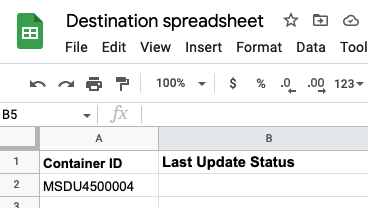No Code Workbook
Discover the power of effortless container tracking with Vizion's No Code Workbook
Vizion offers a No Code Workbook to start tracking containers immediately without using any code. All you need is a Vizion API key and a Google Account. The workbook provides the following tabs:
- Containers - Lists all containers that are actively being tracked. This tab is where the calls to the Vizion API are made to subscribe to a given set of containers.
- JSON - All of the updates generated for active containers will appear here. This tab updates about every minute and flattens the data into a user-friendly, readable format.
- Archive - Assists in cleaning up the track-and-trace.
Use data from the No Code Workbook in a different Google Sheet
To link a cell with Vizion data to the other Google Sheet that you are working with, first copy the link to your No Code Workbook.
Next, in your destination spreadsheet, click on the cell where you want to display Vizion data. For this example, we will use an existing cell containing a container ID that we want to use to search for the last status provided by Vizion.

In the cell next to the container ID, enter a formula following the format below:
=VLOOKUP(cell_containing_value_to_search_in_no_code_workbook, IMPORTRANGE("link_to_Vizion_No_Code_Workbook", "sheet_name!A:Z"), index_of_column_of_data_you_want_to_show_from_No_Code_Workbook, 0))Once you insert the formula, you will see data from your No Code Workbook appear in your destination spreadsheet. This data will update when it is updated by the Vizion API in your No Code Workbook.

Use data from the No Code Workbook in an Excel spreadsheet
These steps will guide you through the process of connecting a Google Sheet to an Excel spreadsheet, allowing you to interact with data from your No Code Workbook in Excel.
- Open your No Code Workbook Google sheet.
- Click on 'File' in the top left corner, then select 'Share' and 'Publish to the web'.
- In the pop-up window, choose 'Link' and 'Entire document' and select 'Excel' as the file type. Click 'Publish' and then copy the link that is provided.
- Open your Excel spreadsheet and click on 'Data' in the top toolbar, then select 'Get Data' and 'From Web'.
- In the 'From Web' pop-up window, paste the link you copied from your No Code Workbook and click 'OK'. This may take a few minutes to load depending on the amount of data in your No Code Workbook.
- Select the 'Flattened JSON' tab from the list and click 'Load'. This will create a new tab with the data.
- Set the refresh interval by going to 'Data' > 'Properties' > 'Query properties', and select the refresh interval and frequency. Choose 'Refresh every 10 minutes". This will ensure any updates to your No Code Workbook will be consistently pulled into the Excel spreadsheet.
- Now you can use Excel formulas, such as VLOOKUP, to reference data from your No Code Workbook in your Excel spreadsheet.
422 error
If you see the error below when attempting to subscribe to containers, this means you have entered a master bill of lading number, but not the carrier code. Make sure to enter the carrier code and resubscribe to the containers:
Exception: Request failed for https://prod.vizionapi.com returned code 422. Truncated server response: {"errors":[{"property":"scac","name":"is_string","message":"scac must be a string"},{"property":"scac","name":"is_not_empty","message":"scac should... (use muteHttpExceptions option to examine full response)
When you see Unknown carrier in the error text, this means that the carrier code has likely been entered incorrectly. Check for extra spaces and compare your carrier codes to our list of supported carriers:
Exception: Request failed for https://prod.vizionapi.com returned code 422. Truncated server response: {"error":"Unknown carrier. If you believe this is an error, please contact support."} (use muteHttpExceptions option to examine full response)Updated 4 months ago